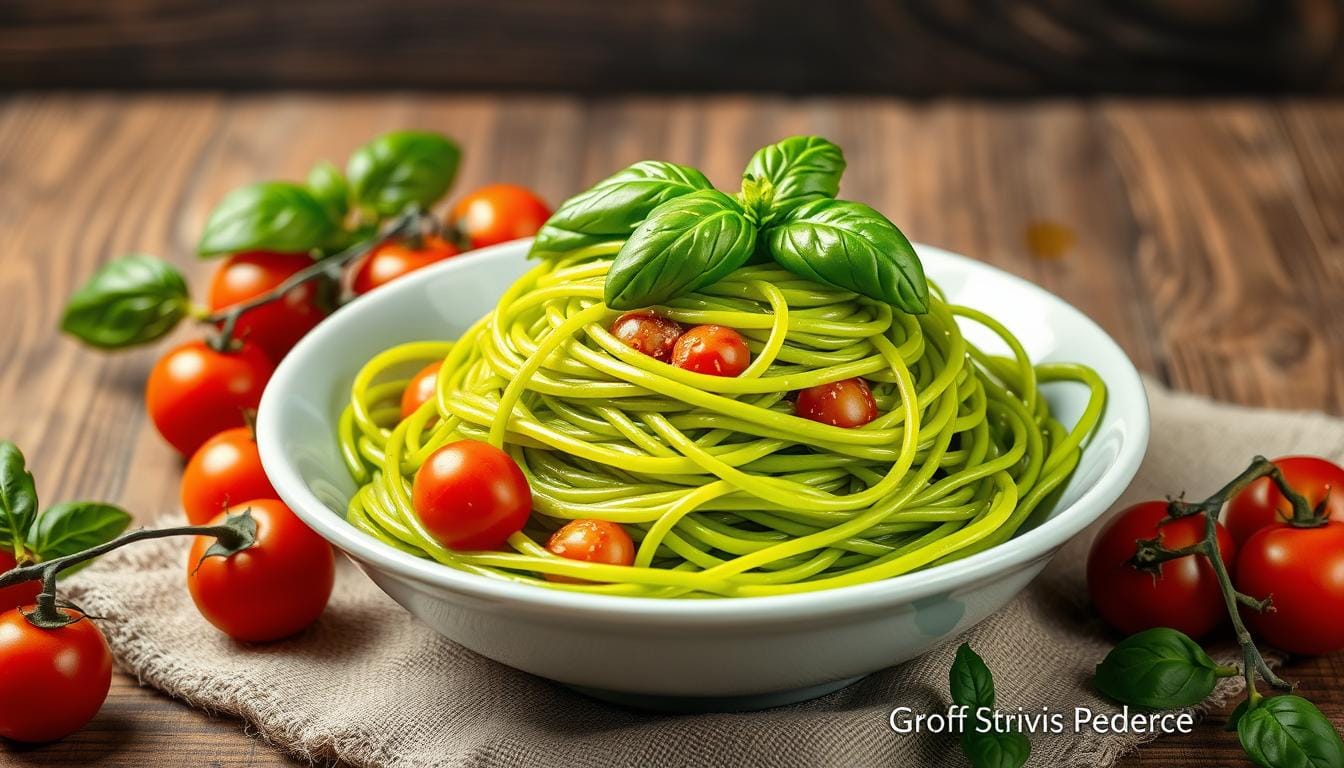Ever wish for a dinner that’s tasty and looks amazing? Green spaghetti might be what you need. I remember being in a busy Mexican kitchen during the holidays. The smell of roasted poblano peppers filled the air.
This experience introduced me to vibrant spaghetti. It’s usually a side dish but can be the main event.
Creamy green pasta is special because of its bright color. It also has a creamy texture from ingredients like Mexican sour cream and cream cheese. At holiday meals, it’s a favorite, going well with meats or tamales.
But green spaghetti is more than just a holiday treat. It’s great for everyday meals too. It’s perfect for those who love healthy pasta or want to try something new.
Ready to explore this colorful dish? Let’s start this tasty journey together.
What Is Green Spaghetti?
Green spaghetti, also known as green noodles or spinach pasta, is a vibrant pasta dish. It’s gaining popularity for its unique color and nutritional benefits. It’s made with natural ingredients like spinach, poblano peppers, or herbs. If you love experimenting with Mexican-inspired dishes, check out this Mexican Spaghetti recipe for another flavorful twist!
Definition and Characteristics
This dish has pasta infused with green ingredients for its distinct hue. The sauce, made from roasted poblano peppers, spinach, and herbs, is creamy and mildly spicy. It’s a staple in Mexican cuisine, known as “espagueti verde.”
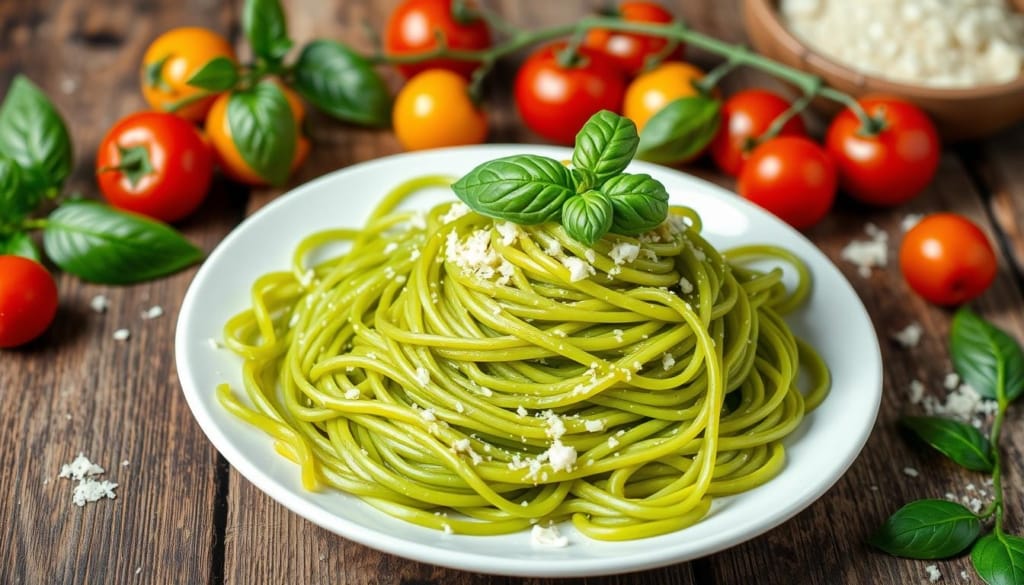
Common Ingredients
The basic components of Healthy green pasta include:
- 1 lb of spaghetti pasta
- 2 roasted poblano peppers (skin, seeds, stem removed)
- 1 roasted bell pepper (skin, seeds, stem removed)
- 8 oz of cream cheese
- 1/2 cup Mexican crema or a mix of heavy cream and whole milk
- 1/2 cup loosely packed cilantro
- 1 garlic clove
- 1 tablespoon of butter
- A few slices of onion (around 1/8 cup)
- Crumbled cotija cheese or queso fresco for topping
If you’re making a vegan version, use cashews and nutritional yeast instead of dairy. Healthy green pasta or veggie noodles can be stored in the fridge for 3-4 days. Or, freeze them for up to 3 months.
| Ingredient | Quantity | Substitutes |
|---|---|---|
| Spaghetti Pasta | 1 lb | Whole wheat, gluten-free pasta |
| Roasted Poblano Peppers | 2 | Charred jalapeno |
| Roasted Bell Pepper | 1 | N/A |
| Cream Cheese | 8 oz | Vegan cream cheese |
| Mexican Crema | 1/2 cup | Heavy cream and whole milk mix |
| Fresh Spinach | 2 cups | Other greens like kale |
| Garlic Clove | 1 | Garlic powder |
For the best taste, blend the roasted peppers, cream cheese, crema, cilantro, garlic, and onion. This makes a smooth, flavorful sauce. It’s perfect for any meal.
The Nutritional Benefits of Green Spaghetti
Spinach spaghetti is not just pretty to look at. It’s also packed with nutrients. It’s a healthier choice than regular pasta.
Rich in Vitamins and Minerals
Green spaghetti is full of vitamins and minerals. Spinach and kale, used in Spinach spaghetti, are rich in vitamins A, C, and K. These vitamins boost your immune system and help your eyes and bones.
Green ingredients also have antioxidants. These fight off stress and help you stay healthy for a long time. Plus, olive oil and nuts add healthy fats to this tasty dish.
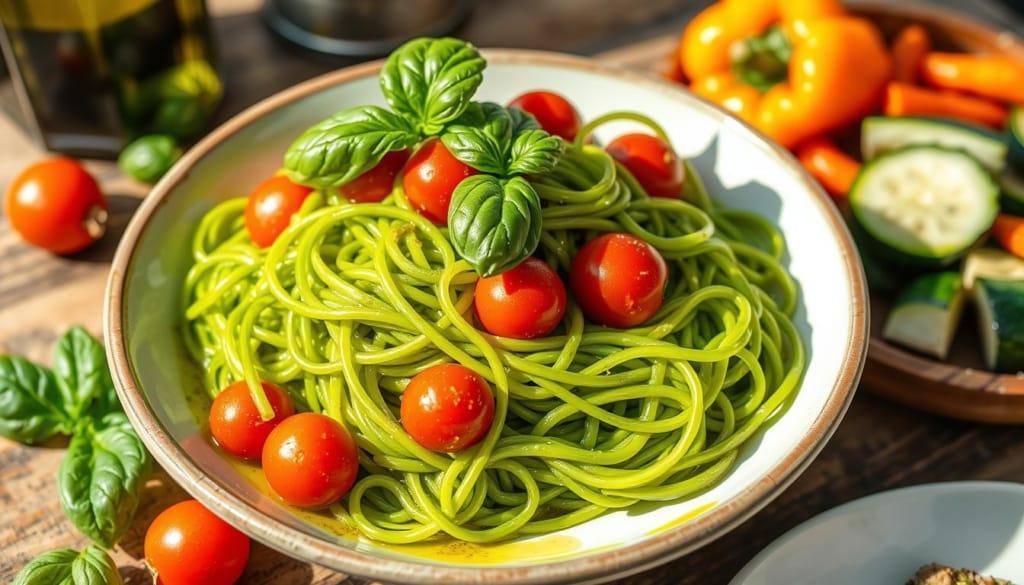
Comparison to Regular Pasta
Spinach spaghetti is different from regular pasta. It has more fiber, which is good for your digestion and keeps you full longer. It’s also lower in calories, making it a great choice for a healthy meal.
| Aspect | Green Spaghetti | Regular Pasta |
|---|---|---|
| Calories | Lower | Higher |
| Fiber | High | Moderate |
| Vitamins | Rich in A, C, K | Less nutrient-dense |
| Fats | Healthy fats from olive oil, nuts | Depends on sauce |
In short,Creamy green pasta is not just a colorful twist on pasta. It’s also a nutritional powerhouse. It’s perfect for anyone looking to add more nutrients to their diet.
How to Make Green Spaghetti at Home
Making homemade Creamy green pasta is easy and fun. It’s a great way to enjoy a tasty meal. Just follow a few simple steps and use fresh ingredients.
Essential Ingredients You Need
First, gather all the ingredients you need:
- 2 large poblano peppers (or 3 small ones)
- 2 tbsp chicken bouillon
- 1⁄2 bunch chopped cilantro
- 2 tbsp minced garlic
- 1 tsp ground black pepper
- 16 oz Mexican sour cream
- 1⁄4 cup milk
- 1⁄4 cup water for the sauce
- 10 cups water to boil the spaghetti
- 8 oz of spaghetti
Step-by-Step Cooking Instructions
- Roast the poblano peppers: Broil the peppers for about 5 minutes until their skins char and blister, then steam for 10 minutes.
- Prepare the sauce: Blend the roasted peppers with chopped cilantro, minced garlic, black pepper, sour cream, milk, and water until smooth.
- Cook the spaghetti: Boil 10 cups of water and cook the spaghetti until al dente, following package instructions.
- Combine and heat: Mix the cooked pasta with the green sauce, warming it for approximately 3 minutes on the stove until thoroughly heated.
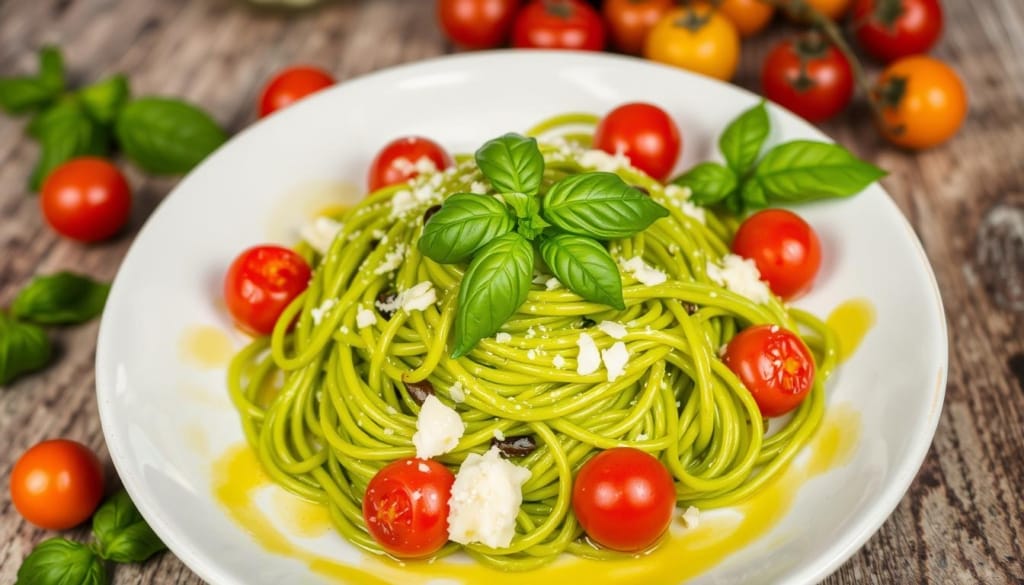
Tips for Perfect Texture
For the best texture, follow these tips:
- Sweat the roasted peppers: Let the roasted poblano peppers cool for at least 20 minutes to make them easier to peel.
- Blending the sauce: Make sure the sauce is blended smoothly for a creamy consistency.
- Al dente spaghetti: Cooking the spaghetti to al dente prevents it from becoming too soft when combined with the sauce.
With these tips, cooking green pasta at home is fun and rewarding. Enjoy your homemade spinach pasta with your favorite protein or a fresh side salad!
Popular Variations of Spinach spaghetti
Creamy green pasta is a fun way to get creative in the kitchen. You can make it with pesto, avocado, or spinach. Each version adds a new twist to pasta.
Pesto Spinach spaghetti
Pesto spinach pasta is a hit. It’s made with basil, pine nuts, garlic, olive oil, and Parmesan cheese. This dish comes from Italy but is loved in Peru too.
In Peru, they call it Tallarines Verdes. It’s made with spinach and served with steak or chicken. You can change it up by using walnuts instead of pine nuts and queso fresco instead of Parmesan.
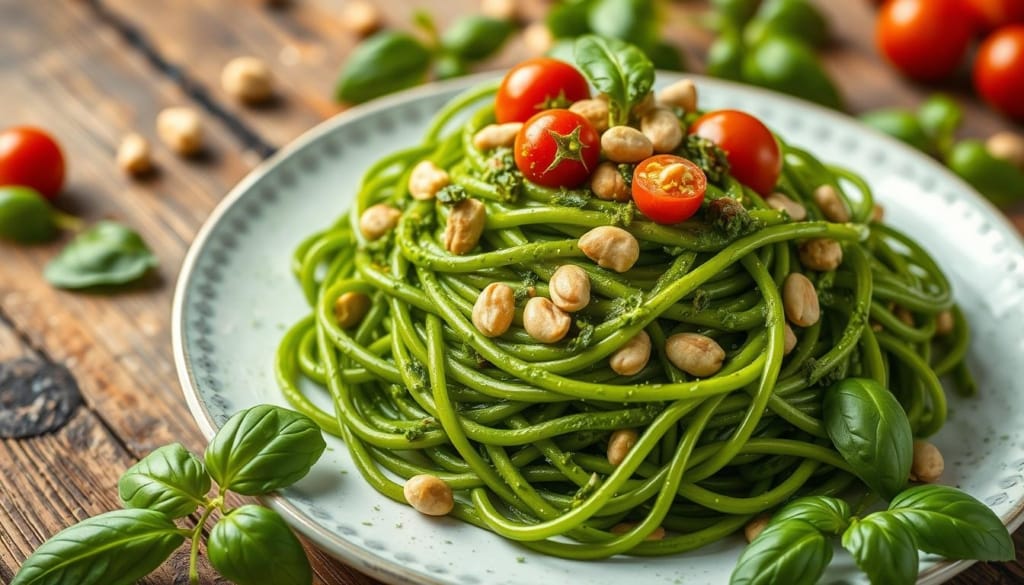
Spinach and Avocado Blend
Spinach and avocado pasta is creamy and healthy. It’s made by blending spinach and avocado. This sauce sticks well to fettuccine or other pasta.
This mix makes the dish more nutritious. Adding garlic, lemon juice, and olive oil makes it taste fresh and rich.
Green Sauce Alternatives
There are many green sauces you can try. One is a creamy poblano pepper sauce. It’s made with poblano peppers, garlic, and more.
You can change it up by using sour cream instead of crema. Adding cotija cheese on top makes it even better. You can serve it with different pasta like farfalle or rigatoni.
| Variation | Key Ingredients | Suggested Accompaniments |
|---|---|---|
| Pesto Green Spaghetti | Basil, pine nuts, garlic, olive oil, Parmesan | Steak, chicken |
| Spinach and Avocado Pasta | Spinach, avocado, garlic, lemon juice, olive oil | Light salad, grilled vegetables |
| Poblano Pepper Sauce | Poblano peppers, garlic, serrano peppers, white onion, crema, milk, cilantro, cream cheese | Roasted chicken, seared shrimp |
Pairing Green Spaghetti with Sauces
A good sauce can make your Spinach spaghetti even better. You can choose from classic or new sauces. Each one brings out the best in green pasta. For a unique pairing, consider serving it alongside Shrimp Salad to elevate your meal with refreshing flavors.
Classic Sauces That Complement Green Pasta
Try pesto or Alfredo sauce with Spinach spaghetti. Pesto’s fresh basil and pine nuts match the pasta’s earthy taste. Alfredo’s creamy texture adds a nice contrast.
- Pesto Sauce: Made with basil, pine nuts, garlic, lemon juice, and Parmesan.
- Alfredo Sauce: Uses heavy cream, butter, and Parmesan for a smooth taste.
Creative Sauce Ideas for Green pasta
For something new, try innovative pasta sauces. A creamy poblano sauce is a great choice. It’s made with roasted poblano peppers, cream cheese, and lime juice.
- Creamy Poblano Sauce: Uses roasted poblanos, cream cheese, and lime juice.
- Roasted Red Pepper Sauce: Mixes roasted bell peppers, garlic, and broth for a deep flavor.
- Lemon Ricotta Sauce: Adds lemon zest and ricotta for a fresh taste.
| Sauce | Ingredients | Flavor Notes |
|---|---|---|
| Pesto | Basil, pine nuts, garlic | Herbaceous, nutty, garlicky |
| Alfredo | Heavy cream, butter, Parmesan | Creamy, rich |
| Creamy Poblano | Roasted poblanos, cream cheese, lime juice | Smoky, rich, tangy |
| Roasted Red Pepper | Roasted bell peppers, garlic, broth | Sweet, savory |
| Lemon Ricotta | Lemon zest, ricotta | Bright, fresh, creamy |
Whether you choose classic or innovative pasta sauces, the right sauce makes your meal special.
Dietary Considerations for Green pasta
Green pasta is great for many diets. You can make it gluten-free, vegan, or vegetarian. This way, everyone can enjoy it.
Gluten-Free Options
For gluten-free pasta, you have many choices. Rice, quinoa, and chickpea pasta are all good. They taste great and are healthy.
| Type of Pasta | Key Benefits |
|---|---|
| Rice Pasta | Easy to digest, a good source of energy. |
| Quinoa Pasta | High in protein and fiber, low glycemic index. |
| Chickpea Pasta | Rich in protein and iron, perfect for a hearty meal. |
Vegan and Vegetarian Adaptations
Vegan spaghetti is easy to make. Just swap out dairy for vegan alternatives. Use vegan crema or almond milk instead.
Vegetarian options are also great. Add tofu, mushrooms, or veggies to your green pasta. It’s tasty and healthy.
Green pasta is very flexible. It works for gluten-free, vegan, or vegetarian diets. It’s a nutritious choice for everyone.
Serving Suggestions for Green Spaghetti
Green spaghetti adds a fun twist to regular pasta. To make it even better, try pairing it with tasty sides and garnishes. Here are some ideas to make your green spaghetti dish stand out.
Ideal Side Dishes
Choosing the right sides can make your meal even better. Here are some great options for green spaghetti:
- A light Caesar salad with crisp Romaine, Parmesan, and croutons for a refreshing bite.
- Steamed vegetables like broccoli, asparagus, or peas to keep the meal balanced and nutritious.
- Garlic bread or a warm baguette to add a crunchy element and to soak up any extra sauce.
- Roasted vegetables, such as bell peppers and cherry tomatoes, for a flavorful and colorful addition.
Garnishing Ideas for Presentation
Good presentation is important when serving green spaghetti. Here are some ideas to make your dish look and taste great:
- Fresh herbs like basil, parsley, or cilantro for a burst of color and freshness.
- Grated cheeses such as Parmesan, Cotija, or Queso Fresco to add a salty, umami kick.
- A light drizzle of high-quality olive oil to enhance the richness of the dish.
- Toasted pine nuts or almonds for a crunchy texture and nutty flavor.
- Lemon zest and juice for a tangy touch that brightens the overall flavor.
By using these serving suggestions and garnishes, you can make your green spaghetti a memorable meal. Whether you’re looking for sides or garnishes, these tips will help your dish impress.
| Recipe | Prep Time | Cook Time | Total Time | Calories per Serving |
|---|---|---|---|---|
| Creamy Poblano Spaghetti | 20 minutes | 20 minutes | 40 minutes | 413 kcal |
Green Spaghetti in Different Cuisines
Green spaghetti is loved worldwide. It’s a hit in Italy and Asia, thanks to its vibrant taste. It fits right in with many cultures.
Italian Inspirations and Recipes
Italian green pasta recipes are full of flavor. They use fresh basil, pine nuts, and Parmigiano-Reggiano. These ingredients make green spaghetti taste amazing with Italian sauces.
Pesto green spaghetti is a favorite. It’s made with basil, garlic, olive oil, and pine nuts. Fresh spinach adds a creamy twist. Enjoy a taste of Italy with every bite.
Asian-Inspired Green Spaghetti Dishes
Asian fusion pasta dishes add a bold twist to green spaghetti. Ingredients like ginger, lemongrass, and soy sauce make it exciting. Stir-frying it with Asian veggies and a tangy sauce is a hit.
For spice, add chili paste. Or, mix in coconut milk for creaminess. These recipes show how green spaghetti fits into international dishes.
How to Store and Reheat Green Spaghetti
Storing and reheating green spaghetti right is key to keeping its taste and texture great. Some important tips can help your green spaghetti stay tasty and fresh, even when stored or reheated.
Best Practices for Storage
When storing pasta, cool it down to room temperature first. Then put it in airtight containers. This stops bacteria from growing and keeps the flavor good. Homemade green spaghetti can stay fresh in the fridge for up to three days. Fresh pasta can be frozen for up to eight months.
It’s best to store pasta and sauce separately. Dried pasta can last a year or more in a cool, dry place.
| Type of Pasta | Storage Method | Duration |
|---|---|---|
| Homemade Green Spaghetti | Refrigerator | Up to 3 days |
| Homemade Green Spaghetti | Freezer | Up to 8 months |
| Purchased Dried Pasta | Pantry | Year or more |
Reheating Tips to Preserve Flavor
When reheating green spaghetti, be careful to keep its flavor and texture good. Adding a bit of water or olive oil helps prevent it from drying out. For example, you can reheat it in the microwave by heating on medium-high for one minute, then in one-minute increments, stirring each time, until it’s warm.
Or, you can dip the pasta in boiling water for about 30 seconds. This adds moisture back to the noodles without sauce.
For bigger portions, use the oven. Put the spaghetti in a shallow dish, cover it with foil, and bake at 350°F for about 20 minutes. To make it extra gooey, remove the foil for the last five minutes and sprinkle Parmesan cheese on top.
Frozen pasta should be reheated by tossing it into boiling water for one to two minutes, without thawing first. For dairy-based pasta dishes, reheat them in a skillet on low heat. Add a bit more milk or cream to prevent drying out.
- Use airtight containers for storing pasta
- Separate pasta from sauce before freezing
- Reheat in microwave in one-minute increments
- Boil frozen pasta without thawing
- Optional: Add Parmesan for an extra gooey texture
By following these tips, your green spaghetti will keep its great taste and color, even days later.
Green Spaghetti in Popular Restaurants
Green spaghetti has become a hit in many top restaurants. It brings vibrant colors and unique tastes to the table. You can find it in many forms, from fancy restaurant-style to creative chef’s versions.
Notable Dishes from Famous Chefs
Green spaghetti is known for its fresh and bold taste. Chefs like Wolfgang Puck and Giada De Laurentiis have made their own versions. Wolfgang Puck’s dish has a strong pesto sauce with arugula and basil, plus grilled shrimp.
Giada De Laurentiis adds charred jalapeno for a spicy kick. Her dish is a favorite among chefs and food lovers alike.
Trendy Restaurants to Try Green Spaghetti
Many trendy spots in the US now serve green spaghetti. At Carbone in New York City, it’s in a creamy avocado and spinach sauce with parmesan. Osteria Mozza in Los Angeles offers it with basil pesto and ricotta cheese.
These places have made green spaghetti a must-try. It’s perfect for a casual meal or a fancy dinner. Green spaghetti offers a unique and tasty experience.
The Environmental Impact of Green Spaghetti
Green spaghetti is more than a colorful twist on a classic dish. It also shows us how to cook in a way that’s good for the planet. Pair your sustainable cooking efforts with recipes like this Vegetarian Stuffed Bell Peppers for a well-rounded, eco-friendly meal. By choosing ingredients that are kind to the earth and buying from local farmers, you can enjoy tasty pasta while helping the environment.
Sustainable Ingredients and Practices
Using ingredients that are good for the planet is key to eco-friendly pasta. For example, a new spaghetti recipe cut down on CO2 emissions. It went from 1.99kg to 1.85kg per serving. This change helps the environment and saves a lot of resources.
Water use is also important. The same new recipe used less water, from 3,341L to 1,751L per serving. This big drop shows how cooking in a green way can save water.
| Metric | Original Recipe | Reformulated Recipe |
|---|---|---|
| CO2 Emissions (kg per serving) | 1.99 | 1.85 |
| Water Usage (L per serving) | 3,341 | 1,751 |
| Calories (kcal per serving) | 757 | 456 |
| Fat Content (g per serving) | 22 | 5.9 |
| Cost per Serving (€) | 1.61 | 1.19 |
Supporting Local Farmers
It’s important to highlight the good of local farming for sustainable cooking. Buying from local farmers helps the community and cuts down on carbon emissions from transport. Their farms are close, so the food is fresher and tastes better. Plus, it helps the local economy and keeps the environment healthy.
In short, choosing sustainable cooking and supporting local farmers makes your green spaghetti both yummy and eco-friendly.
Creative Uses for Leftover Green Spaghetti
Leftover green spaghetti can be more than just a simple meal. You can turn it into new dishes and reduce food waste. It’s a great way to get creative with pasta and make exciting meals.
Unique Recipes to Prevent Waste
There are many ways to make leftover green spaghetti exciting. Try mixing it into a frittata with cheese, garlic, and olives. It’s a nutritious choice, with calories ranging from 264 to 533 per serving.
You can also add it to a fresh salad. Mix it with veggies and a light dressing for a healthier meal. This not only cuts down on waste but also adds a fun twist to usual dishes.
Incorporating into Other Dishes
Green spaghetti is great for making new dishes. Try making a creamy casserole with cream, cheese, and anchovies. It’s a savory treat, with sodium levels from 431mg to 1961mg per serving.
Another idea is to add it to soups or stews. It adds volume and texture. By using green spaghetti in other dishes, you can create tasty meals that are full of flavor and creativity.
FAQ
What is green spaghetti?
Green spaghetti is a fun twist on regular pasta. It uses natural green ingredients like spinach and herbs. This makes it not only look good but also healthier.
What are the common ingredients in green spaghetti?
Green spaghetti often includes spinach for color and nutrition. Poblano peppers add a creamy texture and a bit of spice. Herbs also play a big role in making it vibrant and nutritious.
How does green spaghetti compare nutritionally to regular pasta?
Green spaghetti is way healthier than regular pasta. It’s packed with vitamins and minerals from spinach and herbs. It also has more fiber and less carbs, making it a better choice for pasta lovers.
How can I make green spaghetti at home?
To make green spaghetti at home, start with fresh ingredients like poblano peppers and spinach. Roast the peppers, blend them, and cook the spaghetti until it’s just right. Then, mix it with a homemade green sauce for the best taste.
What are some popular variations of green spaghetti?
There are many green spaghetti variations. You can try pesto with basil and pine nuts, or spinach and avocado blends. There are also green sauces made from different veggies and herbs for everyone’s taste.
What sauces pair well with green spaghetti?
Pesto or Alfredo sauces are great with green spaghetti. They enhance its taste without overpowering it. For a richer flavor, try sauces with roasted poblano peppers.
Are there dietary adaptations available for green spaghetti?
Yes, green spaghetti can be made for different diets. Use gluten-free pasta for those with dietary restrictions. You can also make it vegan or vegetarian by using plant-based ingredients.
What are the best side dishes to serve with green spaghetti?
Serve green spaghetti with light Caesar salads or steamed veggies. Add fresh herbs, grated cheese, or olive oil for extra flavor and color.
How is green spaghetti used in different cuisines?
Green spaghetti fits into many cuisines. In Italy, it’s made with herbs. In Asia, it’s flavored with ginger and lemongrass for a unique taste.
What are the best practices for storing and reheating green spaghetti?
Cool green spaghetti to room temperature before storing it in airtight containers. When reheating, add a bit of water or olive oil to keep it moist and flavorful.
Where can I find green spaghetti in popular restaurants?
Famous chefs and trendy restaurants often have green spaghetti on their menus. Trying these dishes lets you enjoy creative and acclaimed recipes.
What is the environmental impact of making green spaghetti?
Making green spaghetti with local, sustainable ingredients helps farmers and the planet. It reduces the carbon footprint of food production, making cooking more eco-friendly.
How can I creatively use leftover green spaghetti?
Use leftover green spaghetti in frittatas, salads, or as a base for new sauces. This boosts your creativity and reduces food waste.

